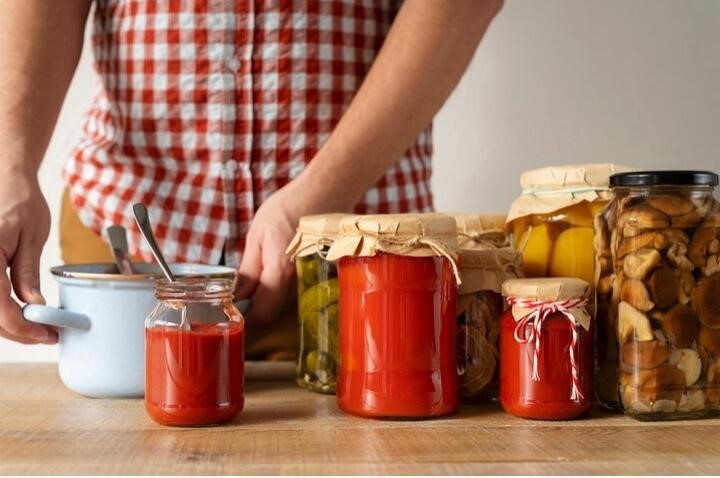The use of preserving jars for canning food has been around for centuries. Preserving fresh produce in airtight glass jars with lids has great advantages. It can prevent food wastage and spoilage if done the right way.
You can also do home canning of foods such as meat and fish at home. It requires using well-sealed and sterilised glass jars with lids. But you need to follow safety guidelines for the safe canning of each type of food. Investigate and adhere to the best practices in home canning from trusted sources.
Canning Foods at Home: Why Safety is Important
Note that you should use fresh, top-quality foods for canning. This is a non-negotiable condition for all foods. It is an important starting point for eliminating contamination.
Microbes like bacteria and moulds float around and cling to objects. That includes raw and exposed foods. But they thrive and produce toxins in moist, oxygen-deficient conditions. This is what canning actually creates, an unfortunate coincidence.
Knowing about safe canning procedures is critical. It will safeguard you and your household from illnesses caused by food contamination. High on that list is botulism - a nervous disorder which can paralyse and even kill its victim. It comes as a result of toxins produced by the bacteria Clostridium botulinum.
6 Golden Rules of Safe Canning at Home

➢ Use the Right Canning Method
The two methods of preparing canned foods at home are by using a pressure canner or a boiling water canner. The acidity or ph level of the food in question determines the canning method to use.
Acidic foods have a ph value of 4.6 or lower. Many fruits fall in this category, including tomatoes. For such foods, you can use boiling water canning. To do so, boil the preserving jars and their contents in a large pot with a rack inside it. Fill the pot with water that can cover between 1 and 2 inches of the height of the preserving jars, and set it to boil. While heating the water, you can lower the filled preserving jars with care, and balance them on the rack.
For lower-acid foods, it is advisable to use a pressure canner. These include meat, poultry, soups, seafood, and vegetables. Pressure canning can produce higher temperatures than boiling water canning. Thus, it kills all microbes.
But, there are foods you should never can at home. They include flour, cornstarch, and thick purees. Their thickness may prevent heating them to temperatures that are high enough. Forget dairy products as well. Because they contain fat, a special target of microbes.
➢ Investigate and Follow Expert Advice
Begin by reading comprehensive guidelines for the safe canning of foods at home. We recommend that you check the following resources on safe canning. They are links to authorities on food management:
➢ Use the Recommended Equipment for Canning
To get excellent results, home canning requires using the right utensils and equipment. Thus, you should have the following important equipment in place:
- Washed and sterilised glass jars with lids. The recommended preserving jars are those created for home canning, in particular. An excellent choice would be wide-mouthed glass jars with lids. The lids must be airtight; 2-piece lids are top choices.
- Canning jar lifter. Use them to remove the jars from the hot water.
- A wide-mouthed funnel for pouring contents into the preserving jars. It should fit well into the mouths of the jars.
- Bubble remover and headspace tool. It removes bubbles from the preserving jars. Again, it measures the right amount of headspace you should leave.
- A magnetic lid lifter can help you remove the hot lid from a canner without burning yourself.
➢ Don't Reinvent Any Canning Recipe: Stick to It
It may be tempting to experiment with recipes. But when it comes to canning, please get canning recipes from trusted sources and stick to them. Any modification may affect the outcome of the canning procedure in a serious way.
➢ About Pressure Canners: Stick to the Instructions
You must note that each pressure canner has its unique set of instructions you must obey. Adhere to the manufacturer's instructions to get the best results. It covers operating rules that cover the recommended pressure, and prescribed boiling time.
➢ Do Storage and Quality Checks
Once the canning is complete, wipe the glass jars with lids clean and label them. Ensure you keep them out of the sunlight. If possible, avoid stacking the preserving jars on top of one another. Move older jars forward, and use them before the newer ones.
Yet again, you should check time and again for any defects. Check for possible leaks, bulges, cracks, faulty seals, or discoloured lids. Also, check for signs of contamination from time to time, such as unpleasant smells or foaming. Once detected, remove the affected jars and discard their contents at once.
Final Words
One of the safest and healthiest methods of preserving food at home is canning. That is, if you follow safety and hygiene procedures prescribed by food experts.
You should also abide by the correct canning recipe for each food without trying to change it. And finally, safe storage and regular checks can help to detect any contaminated food on time.

